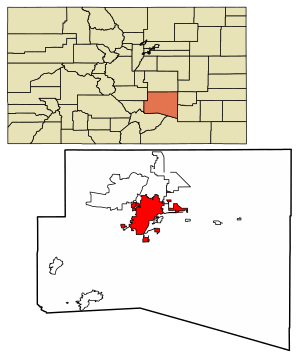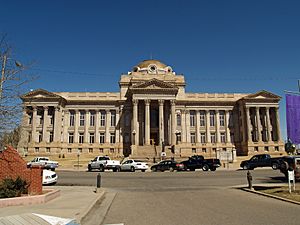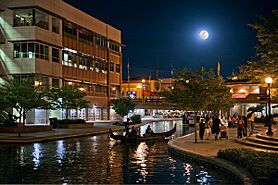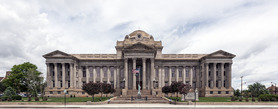Pueblo, Colorado facts for kids
Quick facts for kids
Pueblo, Colorado
|
|||
|---|---|---|---|
|
Historic Arkansas Riverwalk at night
Colorado State University-Pueblo
Pueblo County Courthouse
|
|||
|
|||
| Nickname(s):
Home of Heroes, Steel City
|
|||
| Motto(s):
"A City Of Excellence"
|
|||

Location of the City of Pueblo in Pueblo County, Colorado
|
|||
| Country | United States | ||
| State | Colorado | ||
| County | Pueblo | ||
| City | Pueblo | ||
| Incorporated | November 15, 1885 | ||
| Government | |||
| • Type | Home rule municipality | ||
| • Body | Pueblo City Council | ||
| Area | |||
| • Total | 56.083 sq mi (145.254 km2) | ||
| • Land | 55.382 sq mi (143.439 km2) | ||
| • Water | 0.701 sq mi (1.815 km2) | ||
| Elevation | 4,692 ft (1,430 m) | ||
| Population
(2020)
|
|||
| • Total | 111,876 | ||
| • Rank | 9th in Colorado 273rd in the United States |
||
| • Density | 1,994.833/sq mi (770.209/km2) | ||
| • Metro | 168,162 (257th) | ||
| • CSA | 217,690 (186th) | ||
| • Front Range | 5,055,344 | ||
| Demonym(s) | Puebloan | ||
| Time zone | UTC−07:00 (MST) | ||
| • Summer (DST) | UTC−06:00 (MDT) | ||
| ZIP Codes |
81001-81012
|
||
| Area code(s) | 719 | ||
| FIPS code | 08-62000 | ||
| GNIS feature ID | 0204798 | ||
| Major Routes | |||
| Website | pueblo.us | ||

Pueblo is a city in Colorado, United States. It is the main city of Pueblo County. In 2020, about 111,876 people lived there, making it the ninth largest city in Colorado. Pueblo is also a big part of the Front Range Urban Corridor.
The city is located where the Arkansas River and Fountain Creek meet. This is about 112 miles (180 km) south of Denver. Pueblo is in a dry, desert-like area. It gets about 12 inches (300 mm) of rain each year. Because of its location, Pueblo usually gets less snow than other big cities in Colorado.
Pueblo is famous for making a lot of steel. This is why it is often called the "Steel City". The Historic Arkansas River Project (HARP) is a riverwalk that tells the story of the big flood in 1921.
Contents
Discovering Pueblo's Past
Early Trading Post: El Pueblo
Around 1842, a trading post called El Pueblo was built. Fur trappers like James Beckwourth helped build it. Sadly, between December 23 and 25, 1854, a group of Utes and Jicarilla Apaches attacked the trading post. This event is known as the Fort Pueblo Massacre. They killed many men and captured some women and children.
After the attack, the trading post was left empty. But it became important again in 1858 and 1859 during the Colorado Gold Rush of 1859.
How Pueblo Grew: Towns, Trains, and Steel
The city of Pueblo today was once four separate towns. These were Pueblo (started in 1870), South Pueblo (1873), Central Pueblo (1882), and Bessemer (1886). These towns joined together to form the City of Pueblo between 1886 and 1894.
Pueblo quickly became an important place in Colorado. By the early 1870s, it was known for its farms. Soon, making steel became a huge industry. In 1909, Pueblo was the only steel town west of the Mississippi River.
Before a series of big floods, especially the Pueblo Flood of 1921, Pueblo was known for making saddles. The 1921 flood destroyed about one-third of Pueblo's downtown businesses. Many buildings were lost. Pueblo worked hard to recover and has grown a lot since then.
Orphanages in Pueblo's History
Pueblo also had several orphanages that helped many children. These were Sacred Heart, Lincoln, and McClelland. Lincoln was special because it was the first orphanage in Colorado for Black children. Sacred Heart was run by the Catholic Church, and McClelland by the Lutheran Church. Some children from Cuba even came to Sacred Heart as part of "Operation Pedro Pan".
Today, these orphanage buildings are no longer used as orphanages. They have been changed for other uses, like housing for families.
The Steel Mill: Colorado Fuel and Iron
The main industry in Pueblo for a long time was the Colorado Fuel and Iron (CF&I) Steel Mill. For almost 100 years, CF&I was the biggest employer in Colorado. In the 1980s, the steel industry faced problems, and CF&I struggled. It was later bought by Oregon Steel Mills and renamed Rocky Mountain Steel Mills.
Today, the steel mill still operates. It uses electric furnaces to recycle scrap metal and produces things like rails, rods, and seamless tubes. Some old buildings from the CF&I plant, like the main office, are now part of the Steelworks Museum of Industry and Culture. This museum helps people learn about Pueblo's steel history.
"Melting Pot of the West"
Because of the steel mill, many people from different countries came to Pueblo for work in the early 1900s. This made Pueblo a very diverse city. At one point, over 40 languages were spoken at the steel mill! People from Ireland, Italy, Germany, Slovenia, Greece, Lithuania, Russia, Hungary, Japan, and African-American communities all came to live in Pueblo.
This mix of cultures created unique neighborhoods. Even today, different cultural groups hold festivals to celebrate their heritage.
Pueblo: Home of Heroes
Pueblo is known as the "Home of Heroes" because four people from the city have received the Medal of Honor. This is the highest award for bravery in the U.S. military. These heroes are William J. Crawford, Carl L. Sitter, Raymond G. Murphy, and Drew D. Dix.
President Dwight D. Eisenhower once joked, "What is it... something in the water out there in Pueblo? All you guys turn out to be heroes!" In 1993, the city of Pueblo officially adopted "Home of Heroes" as its tagline. There is a special memorial for these heroes at the Pueblo Convention Center.
Pueblo's Location and Weather
Geography of Pueblo
Pueblo is about 100 miles (160 km) south of Denver. It sits at the edge of the Rocky Mountains and the Great Plains. The area is a high desert in southern Colorado.
The city covers about 56 square miles (145 square kilometers). A small part of this area, about 0.7 square miles (1.8 square kilometers), is water.
Pueblo's Climate
Pueblo has a Semi-arid climate, which means it's quite dry. It has four different seasons. Winters are usually mild, but temperatures can drop below freezing. Snowfall is usually light and doesn't stay on the ground for long. January is the snowiest month, but snow is rare in October, May, or September.
Summers are hot and dry. Temperatures often reach 90°F (32°C) or higher. Days can be very hot, but nights cool down a lot. Pueblo gets a lot of sunshine throughout the year, almost 3,470 hours annually.
The hottest temperature ever recorded in Pueblo was 109°F (43°C) on July 13, 2003. The coldest was -31°F (-35°C) on February 1, 1951.
| Climate data for Pueblo, Colorado (Pueblo Memorial Airport), 1991–2020 normals, extremes 1888–present | |||||||||||||
|---|---|---|---|---|---|---|---|---|---|---|---|---|---|
| Month | Jan | Feb | Mar | Apr | May | Jun | Jul | Aug | Sep | Oct | Nov | Dec | Year |
| Record high °F (°C) | 81 (27) |
82 (28) |
86 (30) |
94 (34) |
102 (39) |
108 (42) |
109 (43) |
105 (41) |
103 (39) |
94 (34) |
85 (29) |
82 (28) |
109 (43) |
| Mean maximum °F (°C) | 70.3 (21.3) |
71.8 (22.1) |
79.9 (26.6) |
86.2 (30.1) |
93.4 (34.1) |
101.2 (38.4) |
103.3 (39.6) |
100.2 (37.9) |
96.3 (35.7) |
88.5 (31.4) |
77.2 (25.1) |
69.3 (20.7) |
103.9 (39.9) |
| Mean daily maximum °F (°C) | 48.4 (9.1) |
51.1 (10.6) |
60.6 (15.9) |
67.3 (19.6) |
77.2 (25.1) |
88.6 (31.4) |
93.4 (34.1) |
90.2 (32.3) |
83.1 (28.4) |
69.7 (20.9) |
56.7 (13.7) |
47.5 (8.6) |
69.5 (20.8) |
| Daily mean °F (°C) | 31.9 (−0.1) |
35.1 (1.7) |
43.9 (6.6) |
51.3 (10.7) |
61.4 (16.3) |
71.8 (22.1) |
77.2 (25.1) |
74.8 (23.8) |
66.6 (19.2) |
52.8 (11.6) |
40.5 (4.7) |
31.7 (−0.2) |
53.2 (11.8) |
| Mean daily minimum °F (°C) | 15.4 (−9.2) |
19.0 (−7.2) |
27.1 (−2.7) |
35.3 (1.8) |
45.6 (7.6) |
55.0 (12.8) |
61.0 (16.1) |
59.4 (15.2) |
50.1 (10.1) |
35.9 (2.2) |
24.2 (−4.3) |
15.9 (−8.9) |
37.0 (2.8) |
| Mean minimum °F (°C) | −4.8 (−20.4) |
−1.2 (−18.4) |
9.6 (−12.4) |
20.9 (−6.2) |
31.0 (−0.6) |
43.4 (6.3) |
52.1 (11.2) |
50.2 (10.1) |
35.9 (2.2) |
18.5 (−7.5) |
5.1 (−14.9) |
−5.2 (−20.7) |
−10.4 (−23.6) |
| Record low °F (°C) | −29 (−34) |
−31 (−35) |
−20 (−29) |
2 (−17) |
23 (−5) |
32 (0) |
39 (4) |
37 (3) |
21 (−6) |
−8 (−22) |
−17 (−27) |
−28 (−33) |
−31 (−35) |
| Average precipitation inches (mm) | 0.29 (7.4) |
0.32 (8.1) |
0.82 (21) |
1.57 (40) |
1.57 (40) |
1.28 (33) |
1.89 (48) |
2.11 (54) |
0.65 (17) |
0.76 (19) |
0.47 (12) |
0.29 (7.4) |
12.02 (305) |
| Average snowfall inches (cm) | 4.9 (12) |
4.7 (12) |
4.5 (11) |
3.4 (8.6) |
0.0 (0.0) |
0.0 (0.0) |
0.0 (0.0) |
0.0 (0.0) |
0.2 (0.51) |
1.9 (4.8) |
4.1 (10) |
4.6 (12) |
28.3 (72) |
| Average extreme snow depth inches (cm) | 2.4 (6.1) |
2.2 (5.6) |
2.1 (5.3) |
1.1 (2.8) |
0.0 (0.0) |
0.0 (0.0) |
0.0 (0.0) |
0.0 (0.0) |
0.0 (0.0) |
0.8 (2.0) |
2.2 (5.6) |
2.4 (6.1) |
5.2 (13) |
| Average precipitation days (≥ 0.01 in) | 3.8 | 4.0 | 5.7 | 7.0 | 7.9 | 6.6 | 9.2 | 8.8 | 4.6 | 4.2 | 4.1 | 3.3 | 69.2 |
| Average snowy days (≥ 0.1 in) | 3.8 | 3.8 | 3.0 | 2.1 | 0.1 | 0.0 | 0.0 | 0.0 | 0.1 | 1.0 | 2.8 | 3.6 | 20.3 |
| Average relative humidity (%) | 57.1 | 52.1 | 48.7 | 43.5 | 44.6 | 44.9 | 49.3 | 51.5 | 50.2 | 47.0 | 57.1 | 56.6 | 50.2 |
| Average dew point °F (°C) | 13.6 (−10.2) |
16.3 (−8.7) |
19.8 (−6.8) |
25.9 (−3.4) |
35.8 (2.1) |
44.1 (6.7) |
52.5 (11.4) |
51.8 (11.0) |
42.6 (5.9) |
30.2 (−1.0) |
23.2 (−4.9) |
15.1 (−9.4) |
30.9 (−0.6) |
| Mean monthly sunshine hours | 231.0 | 227.3 | 284.0 | 315.1 | 344.2 | 360.0 | 358.8 | 336.8 | 298.7 | 275.5 | 219.7 | 210.7 | 3,461.8 |
| Percent possible sunshine | 76 | 75 | 77 | 80 | 78 | 81 | 80 | 80 | 80 | 79 | 72 | 71 | 78 |
| Source 1: NOAA | |||||||||||||
| Source 2: National Weather Service | |||||||||||||
People of Pueblo: Demographics
| Historical population | |||
|---|---|---|---|
| Census | Pop. | %± | |
| 1870 | 666 | — | |
| 1880 | 3,217 | 383.0% | |
| 1890 | 24,558 | 663.4% | |
| 1900 | 28,157 | 14.7% | |
| 1910 | 41,747 | 48.3% | |
| 1920 | 43,050 | 3.1% | |
| 1930 | 50,096 | 16.4% | |
| 1940 | 52,162 | 4.1% | |
| 1950 | 63,685 | 22.1% | |
| 1960 | 91,181 | 43.2% | |
| 1970 | 97,774 | 7.2% | |
| 1980 | 101,686 | 4.0% | |
| 1990 | 98,640 | −3.0% | |
| 2000 | 102,121 | 3.5% | |
| 2010 | 106,595 | 4.4% | |
| 2020 | 111,876 | 5.0% | |
| U.S. Decennial Census | |||
Pueblo is a diverse city. In 2020, the population was 111,876. About 49.28% of the people were of Hispanic or Latino background. About 42.91% were non-Hispanic White. Other groups included Black or African American, Native American, and Asian people.
The city has grown steadily over the years. In 2000, there were about 102,121 people living in Pueblo. By 2010, this number grew to 106,544.
Pueblo's Economy and Jobs
Pueblo is home to the Federal Citizen Information Center. This center helps Americans get information from the government. For many years, people would write to "Pueblo, Colorado, 81009" to get free booklets.
Pueblo is also a leader in renewable energy. Vestas Wind Systems built a very large factory here to make wind turbine towers. This factory was later sold to CS Wind.
Renewable Energy Systems Americas also built the Comanche Solar Project near Pueblo. This is one of the largest solar energy farms east of the Rocky Mountains. It produces enough electricity for many homes. Pueblo is becoming a top spot for solar energy companies.
In 2017, Pueblo City Council decided to aim for 100% renewable energy by 2035. This shows the city's commitment to a greener future.
Top Employers in Pueblo
Many people in Pueblo work for large organizations. Here are some of the biggest employers:
- Parkview Medical Center (a hospital)
- Colorado Mental Health Hospital in Pueblo
- Pueblo School District 60
- Colorado State University Pueblo
- Walmart stores
- Pueblo County government
- Pueblo County School District 70
- Evraz Rocky Mountain Steel (the steel mill)
- City of Pueblo government
- Trane Commercial Systems
Arts, Culture, and Fun in Pueblo
Pueblo hosts the Colorado State Fair every summer. This is the biggest single event in Colorado. The city also has an annual Chile & Frijoles Festival, celebrating local foods.
Places to Visit and Explore
Pueblo has many interesting places to visit:
- Rosemount Museum: A beautiful historic mansion.
- Sangre de Cristo Arts and Conference Center: A place for art and performances.
- Buell Children's Museum: A museum especially for kids.
- El Pueblo History Museum: Learn about Pueblo's past.
- Lake Pueblo State Park: Great for outdoor activities like boating and fishing.
- Nature and Wildlife Discovery Center: Explore local nature and animals.
- Pueblo Ice Arena: A place for ice skating.
- Pueblo Zoo: See animals from around the world.
- Steelworks Museum: Learn about Pueblo's steel industry history.
- Union Avenue Historic Commercial District: A historic area with shops and restaurants.
- Weisbrod Aircraft Museum: See old airplanes.
- Pueblo City-County Library District: Find books and learn new things.
Sports in Pueblo
Pueblo is proud of its sports history. Dutch Clark, a famous football player, is from Pueblo. He was one of the first people from Colorado to join the Pro Football Hall of Fame. The main football stadium for Pueblo School District 60 is named after him.
Two high schools, Central Wildcats and Centennial Bulldogs, have a very old football rivalry called The Bell Game. It has been played every year since 1892.
In 2008, Professional Bull Riders (PBR) moved its main office to Pueblo. This is where they plan their bull riding events.
The Colorado State University Pueblo ThunderWolves football team won the NCAA Division II Football Championship in 2014. This was their first national title!
Pueblo also has a junior ice hockey team called the Pueblo Bulls. They play in the United States Premier Hockey League.
Education in Pueblo
Colleges and Universities
Pueblo is home to Colorado State University Pueblo (CSU Pueblo). This university has about 4,500 students. In 2007, CSU Pueblo brought back its football team. They play at the ThunderBowl stadium, which can hold over 12,000 fans.
Pueblo Community College (PCC) is a two-year college. It helps students get ready for jobs or to transfer to a four-year university. PCC has about 5,000 students each semester. It is a Hispanic Serving Institution, meaning it has a large number of Hispanic students.
Schools for Younger Students
Most of Pueblo's schools are part of Pueblo School District 60. A small part of the city is in Pueblo County School District 70.
Pueblo has several high schools:
- Centennial High School (founded in 1876)
- Central High School (founded in 1882)
- South High School
- East High School
- Pueblo County High School (for students outside the city)
- Pueblo West High School
Dolores Huerta Preparatory High School is a special school where many students can earn their associate degree from Pueblo Community College while still in high school.
Media in Pueblo
Newspapers and Magazines
Pueblo has several local newspapers and magazines, including:
- The Pueblo Chieftain
- PULP News Magazine
- Senior Beacon
Radio and Television
Pueblo has many local radio stations. Because it's close to Colorado Springs, people in Pueblo can also listen to radio stations from that city.
Pueblo is part of the Colorado Springs–Pueblo television market. This means you can watch TV channels that serve both cities.
Getting Around Pueblo: Transportation
Buses
The City of Pueblo has its own bus service called Pueblo Transit. For longer trips, Greyhound Lines offers bus service to cities like Denver and Albuquerque, New Mexico. The CDOT also runs a regional bus service called Bustang to nearby towns.
Trains
Pueblo used to be a very important train hub. Today, freight trains from BNSF and Union Pacific still use the tracks.
Amtrak's Southwest Chief passenger train stops about 64 miles (103 km) east of Pueblo in La Junta. This train can take you to Los Angeles, Chicago, and other cities. There are plans to possibly bring passenger train service directly to Pueblo in the future.
Air Travel
Pueblo Memorial Airport is the local airport. You might see large military planes like C-130s and C-17s taking off and landing there. Modern fighter jets like the F-22 and F-35 are also sometimes seen. SkyWest Airlines offers daily flights to Denver International Airport.
The airport is also home to the Pueblo Weisbrod Aircraft Museum. This museum shows off old airplanes and tells the story of the airport, which started as an Army Air Corps base in 1943.
Famous People from Pueblo
Many interesting people have come from Pueblo:
Military Heroes
- William J. Crawford: A Medal of Honor winner from World War II.
- Drew Dennis Dix: A Medal of Honor winner from the Vietnam War.
- Raymond G. Murphy: A Medal of Honor winner from the Korean War.
- Carl L. Sitter: A Medal of Honor winner from the Korean War.
- Cathay Williams: The first African-American woman to join the United States Army.
Business Leaders
- David Packard: Co-founder of Hewlett-Packard computers, who graduated from Pueblo Centennial High School.
Artists and Entertainers
- Kent Haruf: A famous novelist.
- E. J. Peaker: An actress who starred in Hello Dolly.
- Kelly Reno: A child actor in The Black Stallion.
- Charles Rocket: A cast member of Saturday Night Live.
- Dan Rowan: Star of Rowan & Martin's Laugh-In, who lived in a Pueblo orphanage.
- Damon Runyon: A famous writer and playwright.
Sports Stars
- Earl "Dutch" Clark: A professional football player and Hall of Famer.
- John Davis: A Major League Baseball pitcher.
- Turk Lown: A Major League Baseball pitcher.
- Marty Servo: A boxing Welterweight Champion of the World.
- Kory Sperry: An NFL tight end.
Sister Cities
Pueblo has "sister cities" around the world. These are cities that have special friendly relationships to promote cultural exchange. Pueblo's sister cities are:
- Bergamo, Italy
- Puebla (city), Mexico
- Maribor, Slovenia
- Chihuahua City, Mexico
- Lucca Sicula, Italy
- Weifang, China
See also
 In Spanish: Pueblo (Colorado) para niños
In Spanish: Pueblo (Colorado) para niños












